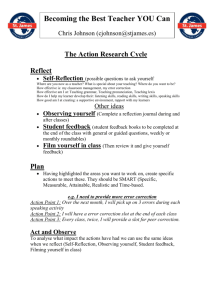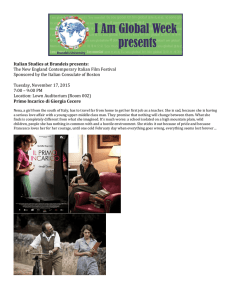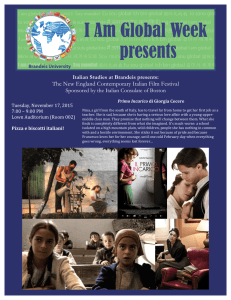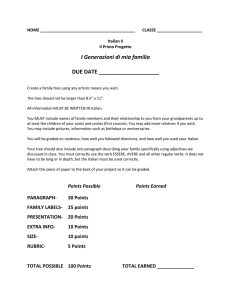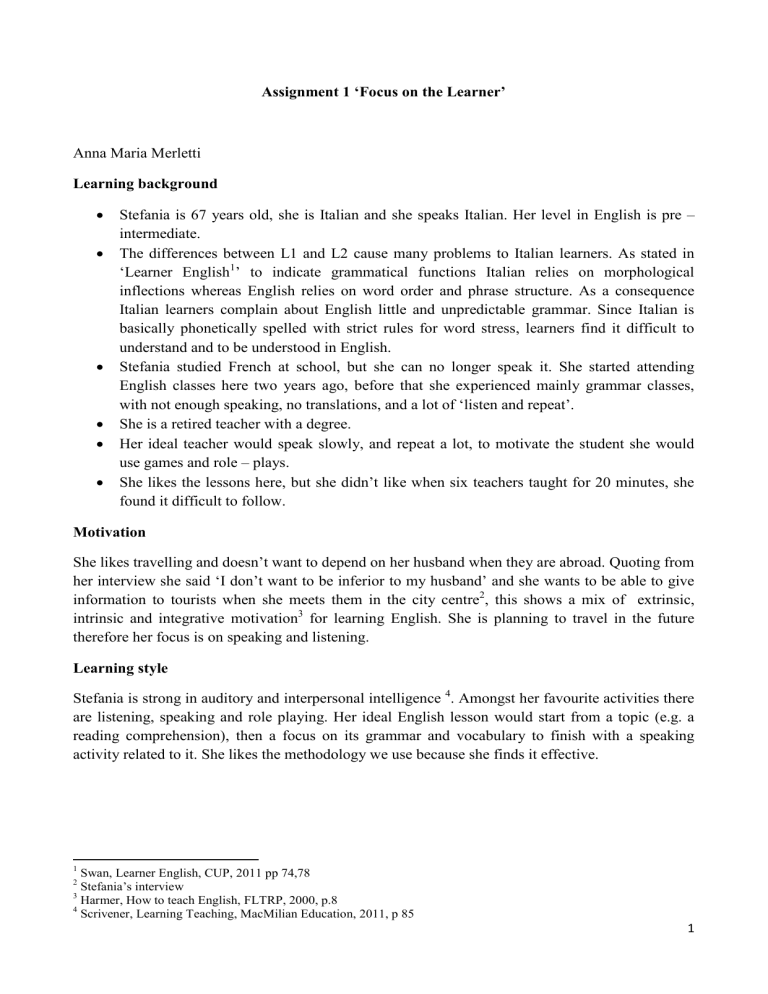
Assignment 1 ‘Focus on the Learner’ Anna Maria Merletti Learning background Stefania is 67 years old, she is Italian and she speaks Italian. Her level in English is pre – intermediate. The differences between L1 and L2 cause many problems to Italian learners. As stated in ‘Learner English1’ to indicate grammatical functions Italian relies on morphological inflections whereas English relies on word order and phrase structure. As a consequence Italian learners complain about English little and unpredictable grammar. Since Italian is basically phonetically spelled with strict rules for word stress, learners find it difficult to understand and to be understood in English. Stefania studied French at school, but she can no longer speak it. She started attending English classes here two years ago, before that she experienced mainly grammar classes, with not enough speaking, no translations, and a lot of ‘listen and repeat’. She is a retired teacher with a degree. Her ideal teacher would speak slowly, and repeat a lot, to motivate the student she would use games and role – plays. She likes the lessons here, but she didn’t like when six teachers taught for 20 minutes, she found it difficult to follow. Motivation She likes travelling and doesn’t want to depend on her husband when they are abroad. Quoting from her interview she said ‘I don’t want to be inferior to my husband’ and she wants to be able to give information to tourists when she meets them in the city centre2, this shows a mix of extrinsic, intrinsic and integrative motivation3 for learning English. She is planning to travel in the future therefore her focus is on speaking and listening. Learning style Stefania is strong in auditory and interpersonal intelligence 4. Amongst her favourite activities there are listening, speaking and role playing. Her ideal English lesson would start from a topic (e.g. a reading comprehension), then a focus on its grammar and vocabulary to finish with a speaking activity related to it. She likes the methodology we use because she finds it effective. 1 Swan, Learner English, CUP, 2011 pp 74,78 Stefania’s interview 3 Harmer, How to teach English, FLTRP, 2000, p.8 4 Scrivener, Learning Teaching, MacMilian Education, 2011, p 85 2 1 Ability in the four skills Stefania’s strongest skills are listening and speaking. When she speaks she can make herself understood even though she is not always accurate or fluent and sometimes lacks of vocabulary. She is not shy and she keeps speaking regardless of her mistakes. When listening she understands complicated structures even though she cannot reproduce them. When she doesn’t understand she asks for clarification. Her problems with reading and writing concern lack of vocabulary and interferences between L1 and L2. She is in the pre – intermediate group nevertheless her production in poor, she seldom has the chance to read something in English, she doesn’t want to read a book because she thinks it may be too difficult for her. In her writing she conveys information and ideas, and she gets across the main points, but this task is the hardest for her, being not used to it. Phonological and grammatical problems, and suggestions for specific activities. Analysing her recorded interview and the written text she provided, I was able to identify errors she regularly makes only from the interview. From the written text it is clear that the mistakes she makes are interferences between the two languages (e.g.: I love reading, to go 5...love followed by – ing form in English, but infinitive in Italian), or she forgets the third person singular auxiliary she usually uses, mistakes she doesn’t make during classes. Grammar Grammatical error 1: Stefania uses the present simple instead of the present continuous. Example 1: ‘The guide speaks’ (oral sample). Correction: The guide is speaking. Example 2: ‘The tourists sunbathe’ (oral sample). Correction: The tourists are sunbathing. Suggestion: Hughes and Jones, Practical Grammar 2, Heinle Cengage (2011) pp 26 – 29, ex 1-4 and 1-3 Hughes, Stephenson, Dummett, Life split B, National Geographic Learning Cengage Learning (2014) (see appendix) Rationale: The progressive verbs exist in Italian, but their use is more limited than in English6, when it comes to describe a picture in English the tense to use is the present continuous7 whereas in Italian we use the equivalent to the present simple. Practice should help her to form the habit. The above exercises include listening exercises which fit with her auditory learning style. Grammatical error 2: preposition after to go. Example 1: ‘I went in the cemetery’ (oral sample). Correction: I went to the cemetery. Example 2: ‘I went at an Italian school’ (oral sample). Correction: I went to an Italian school. Suggestion: Murphy, English Grammar in use, (2012) pp 252 – 253 ex 1 - 3 (see appendix) 5 Stefania’s written text (see appendix) Swan, Learner English, CUP, 2011 p. 80 7 http://learnenglishteens.britishcouncil.org/exams/speaking-exams/describe-photo-or-picture (on 26th November 2017) 6 2 Rationale: The meaning of some prepositions can be a bit difficult to remember in both Italian and English8. The prepositions of movement and position, to/from, are used to show direction with movement9, Stefania doesn’t use the preposition to correctly, these exercises should help her, they include vocabulary related to travelling which is useful and interesting for her future plans. Phonology Phonological error 1: Stefania doesn’t pronounce the letter h at the beginning of a word. Example 1: she says /əʊm/ (oral sample). Correction: /həʊm/ Example 2: she says /ɒl.ə.deɪ/ (oral sample). Correction: /ˈhɒl.ə.deɪ/ Suggestion: Baker, Ship or Sheep, CUP (2006) pp 130 – 132 Rationale: These exercises will help Stefania to practice the sound and get the habit of producing it. The recording fits with her auditory learning style. Phonological error 2: Stefania pronounces /t/ the sound /θ/ Example 1: /tri:/ (oral sample). Correction: /θriː/ Example 2: /tæŋk/ (oral sample). Correction /θæŋk/ Suggestion: Baker, Ship or Sheep, CUP (2006) pp 133, 136 – 137 Rationale: These exercises will help Stefania to recognise the difference between the two sounds and repeating the words will help her to pronounce correctly. The dialogue is entertaining so the self practice is not boring. Word count: 1029 8 9 Swan, Learner English, CUP, 2011 p. 87 Alexander, Longman English Grammar Practice Self-study Edition, Longman, 1990, p 108 3 References: Swan, Learner English, CUP, 2011 Harmer, How to teach English, FLTRP, 2000 Scrivener, Learning Teaching, MacMilian Education, 2011 Alexander, Longman English Gramar Practice Self-study Edition, Longman, 1990 Common European Framework of Reference for Languages, CUP, 2004 http://learnenglishteens.britishcouncil.org/exams/speaking-exams/describe-photo-or-picture Baker, Ship or Sheep, CUP 2006 Hughes and Jones, Practical Grammar 2, Heinle Cengage 2011 Murphy, English Grammar in use, CUP 2012 Hughes, Stephenson, Dummett, Life split B, National Geographic Learning Cengage Learning (2014) 4
